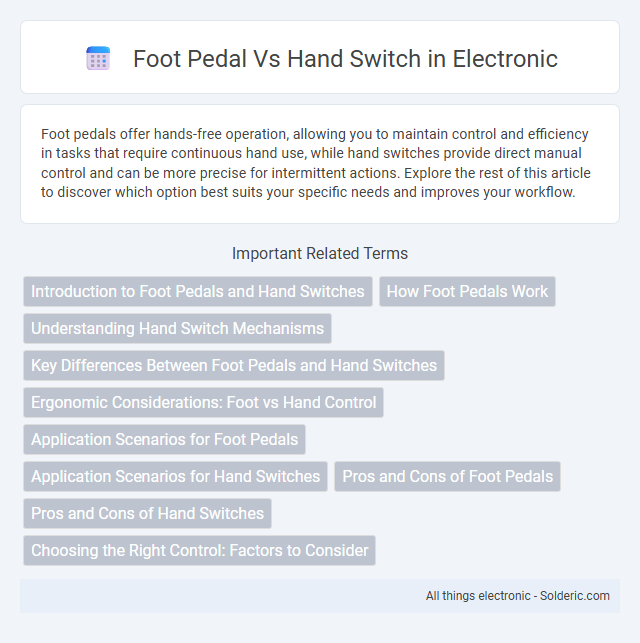Foot pedals offer hands-free operation, allowing you to maintain control and efficiency in tasks that require continuous hand use, while hand switches provide direct manual control and can be more precise for intermittent actions. Explore the rest of this article to discover which option best suits your specific needs and improves your workflow.
Comparison Table
| Feature | Foot Pedal | Hand Switch |
|---|---|---|
| Operation | Activated by foot pressure | Activated by hand press |
| Hands-Free Use | Yes, allows hands-free operation | No, requires hand engagement |
| Typical Applications | Industrial machinery, sewing machines, medical devices | Power tools, control panels, assistive technology |
| Ergonomics | Reduces hand fatigue, may cause foot fatigue | May cause hand/finger fatigue with extended use |
| Portability | Usually fixed or larger, less portable | Compact, easy to carry |
| Response Speed | Moderate, depends on foot dexterity | Fast, controlled with fingers |
| Cost | Generally affordable, varies by complexity | Varies widely, often cheaper than foot pedals |
Introduction to Foot Pedals and Hand Switches
Foot pedals and hand switches serve as essential control devices in various industrial and medical applications, offering distinct advantages based on ergonomic needs and operational efficiency. Foot pedals enable hands-free operation, improving multitasking capabilities and reducing hand fatigue, while hand switches provide precise manual control suitable for tasks requiring intricate manipulation. Selecting between these devices depends on the specific workflow requirements and the environment in which they are used.
How Foot Pedals Work
Foot pedals operate by converting the pressure applied by your foot into an electrical signal that activates a device, allowing for hands-free control. They typically use mechanical or electronic sensors to detect movement, making them ideal for applications requiring precision and efficiency, such as medical equipment, machinery, or musical instruments. Understanding how foot pedals work can help you choose the best control method for tasks that benefit from keeping your hands free while maintaining accurate input.
Understanding Hand Switch Mechanisms
Hand switch mechanisms operate using manual activation, typically through pressing, toggling, or sliding motions, allowing precise control over electrical circuits. These switches often incorporate mechanical components such as springs, contacts, and levers to ensure reliable engagement and disengagement, making them suitable for applications requiring deliberate user input. Understanding the design and functionality of your hand switch can help optimize its use in controlling devices where hand operation is preferred over foot pedals.
Key Differences Between Foot Pedals and Hand Switches
Foot pedals and hand switches differ primarily in their mode of operation and ergonomic design, with foot pedals allowing hands-free control while hand switches require manual activation. Foot pedals are ideal for tasks needing continuous or repetitive input, enhancing workflow efficiency by freeing your hands, whereas hand switches offer precise, localized control suited for detailed operations. The choice between them depends on your specific application needs, such as mobility, ease of use, and the nature of the task.
Ergonomic Considerations: Foot vs Hand Control
Foot pedals reduce hand fatigue by allowing you to control devices with your feet, freeing your hands for other tasks and promoting better posture during prolonged use. Hand switches provide precise control but may increase strain on your fingers and wrist during repetitive actions. Choosing between foot pedal and hand switch depends on the specific ergonomic requirements of your workspace and the intensity of manual tasks performed.
Application Scenarios for Foot Pedals
Foot pedals are ideal for applications requiring hands-free control, such as sewing machines, medical equipment, and industrial machinery, allowing users to maintain manual precision without interruption. In scenarios where multitasking is essential, foot pedals enhance workflow efficiency by enabling continuous operation without diverting hand attention. Your choice between a foot pedal and hand switch depends on the need for hands-free functionality and the specific demands of the work environment.
Application Scenarios for Hand Switches
Hand switches are ideal for industrial machinery control, medical equipment, and manufacturing automation where precise hand operation and quick access are critical. These devices enhance safety and efficiency by allowing your hand to instantly engage or disengage equipment, especially in environments requiring frequent, rapid input. Their ergonomic design supports continuous use in assembly lines, diagnostic tools, and robotic controls, providing reliable, intuitive interaction in diverse application scenarios.
Pros and Cons of Foot Pedals
Foot pedals offer hands-free operation, improving efficiency and allowing users to maintain control over their hands for other tasks, which is especially beneficial in medical, industrial, and musical applications. However, foot pedals may cause fatigue during prolonged use and require adequate foot space, potentially leading to ergonomic challenges or accidental activation. Compared to hand switches, foot pedals reduce hand strain but might have slower response times depending on design and user dexterity.
Pros and Cons of Hand Switches
Hand switches offer precise control and easy accessibility, making them ideal for tasks requiring frequent on-off toggling. They provide ergonomic comfort by reducing foot fatigue compared to foot pedals but may limit mobility since your hands remain occupied. Choosing a hand switch can enhance your workflow efficiency if your task demands fine manual operation and constant hand presence.
Choosing the Right Control: Factors to Consider
Selecting between a foot pedal and a hand switch depends on the specific application, ergonomic requirements, and operational efficiency. Foot pedals are ideal for tasks requiring hands-free control and prolonged use, reducing hand fatigue, while hand switches offer precise, quick access for short or intermittent actions. Consider factors such as user comfort, task frequency, safety needs, and the environment to ensure optimal control device performance and workflow integration.
foot pedal vs hand switch Infographic

 solderic.com
solderic.com